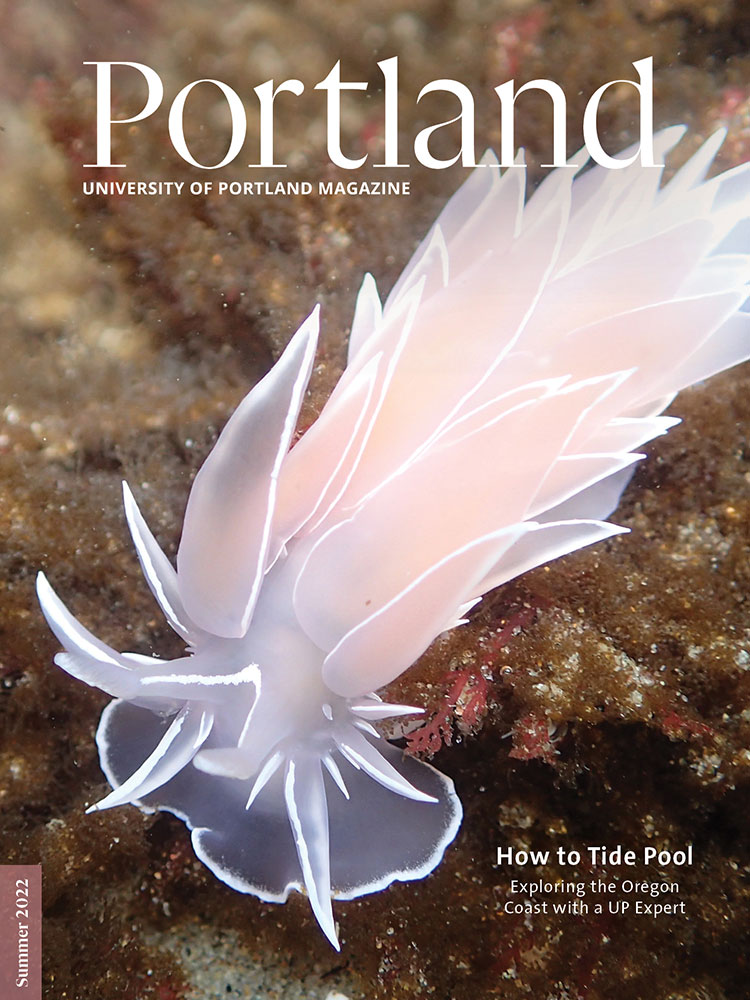
Portland Magazine
June 1, 2022
 I LIKE TO imagine you holding this little magazine—the University’s message in a bottle—and wondering over the cover. What in the world is this magical creature?
I LIKE TO imagine you holding this little magazine—the University’s message in a bottle—and wondering over the cover. What in the world is this magical creature?
Lucky for us all, a liberal arts university opens doors to name such wonders. I’m delighted to report that it is a white-lined dirona, species name Dirona albolineata, and it is a type of sea slug or Eastern Pacific Ocean nudibranch. Those translucent, otherworldly chalk-lined petal-like extremities—called cerata—can be white, pink, or, like our cover model, both. Bonus: you don’t need to be a deep-sea diver to see them. These little miracles live on the Oregon Coast. Professor Tara Prestholdt photographed the cover image off Cape Perpetua and she has some tips for finding them in one of our state’s many tide pools. They typically grow to five or six centimeters—all of this exquisite detail in the length of a stick-and-a-half of gum. It’s also a predator, with tiny jaws that can chomp through a snail shell.
If my family and I are fortunate enough to find a white-lined dirona—and you can be sure we’ll try this summer—we won’t touch it. Because if we do, their defense mechanism will kick in: they’ll shed those cerata, scattering all that beauty to distract us while it escapes. But like the lizard who sheds its tail, this nudibranch can regrow its petals, though it takes time and energy to do so. I can already hear myself shouting at the kids—Do not touch that nudibranch! Do not cause it unnecessary stress and fear!
Nature! I find it incredible that this animal has the capacity to regrow its limbs, to regenerate. Although it takes a tremendous amount of work, it can return to its former glory. While we humans can’t regenerate limbs—a realization that has in the past been a great disappointment to my son’s active imagination—I wonder and hope and pray that we share with this tiny wild creature some ability to build ourselves back up, to renew ourselves, even—especially—out of our darkest hours.
I’m taking a bit of courage from Alena Romanyuk, a UP nurse alum whose story you’ll find in this issue, who recently flew to Ukraine with medical supplies. Her story has nothing to do with the white-lined dirona, but it has everything to do with defiant acts of renewal in the face of the immense stress and fear of war. She says there is always something you can do. I believe her.
I am reminded of the wise words of one of UP’s recent Christus Magister awardees, Sr. Marilyn Lacey, RSM, who has devoted much of her life’s work to the empowerment of refugees, many from regions ravaged by war. She told me (and I’m paraphrasing): If all I did was read the newspaper, I’d feel despair. But if I do some of the work, I end up feeling hope.
— Jessica Murphy Moo, Editor
University of Portland
5000 N. Willamette Blvd.,
Portland, Oregon 97203-5798
503.943.8000
This website uses cookies to track information for analytics purposes. You can view the full University of Portland privacy policy for more information.
